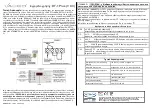
3
The equipment room must also meet limits on salts, acids, and sulfides to eliminate corrosion and
premature aging of components, as shown in
.
Table 3
Harmful gas limits in the equipment room
Gas Max.
(mg/m
3
)
SO
2
0.2
H
2
S 0.006
NH
3
0.05
Cl
2
0.01
Cooling
•
Leave a minimum of 10 cm (3.94 in) of clearance around the device.
•
A good ventilation system is available at the installation site.
ESD prevention
The device might be damaged by the following Electrostatic discharge (ESD) sources:
•
Outdoor environment
—For example, high-voltage power line and lightning.
•
Indoor environment
—For example, floor carpet.
•
Device internal system
.
To prevent ESD damage, follow these guidelines:
•
Ground the device reliably.
•
Take dust-proof measures for the equipment room. For more information, see "
•
Maintain the humidity and temperature at acceptable levels. For more information, see
"
•
Wear an ESD suit and an ESD wrist strap, wear ESD gloves, and remove any electrically conducting
objects such as watch or jewelry before handling the device.
EMI
All electromagnetic interference (EMI) sources, from outside or inside of the device and application
system, adversely affect the device in the following ways:
•
A conduction pattern of capacitance coupling.
•
Inductance coupling.
•
Electromagnetic wave radiation.
•
Common impedance (including the grounding system) coupling.
To prevent EMI, perform the following tasks:
•
If AC power is used, use a single-phase three-wire power receptacle with protection earth (PE) to
filter interference from the power grid.
•
Keep the device far away from radio transmitting stations, radar stations, and high-frequency
devices.











































